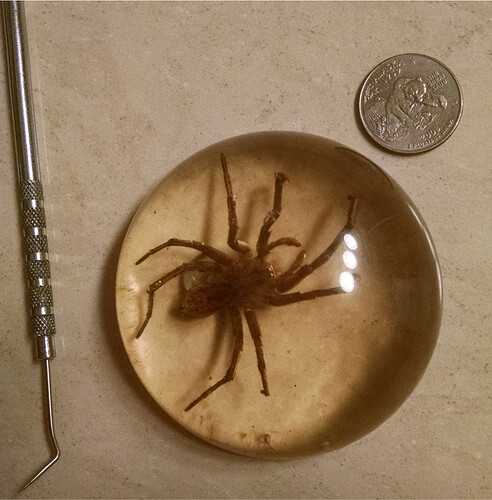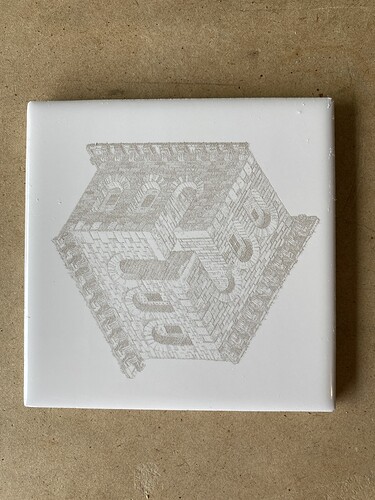the difference between a 20hr 3D print and a 6 hour engrave is that with a 20hr 3D print, you could drive to another state, sleep overnight, and come back the next day to see how your print turned out. a 6 hr engrave you have to babysit so you don’t burn down your house.
I’ve seen plenty of pics of fires from 3D printers.
A 6hr engrave on tile has no such problems.
while i don’t watch a tile engrave like i would wood or acrylic, are you saying you would leave your GF running, leave your house and go run errands for 6 hours while it runs.
maybe you’re right? i haven’t seen them. every architecture firm i know of runs long overnight 3D prints when people are out of the office. nobody runs the laser cutter overnight while they’re gone.
not saying it’s impossible, but they’re really not comparable fire risks.
Tile not flammable. 3d print plastic far more flammable. Any electrical machine can have a short and burn, but in the case of lasering tile, the print has the edge. I would not want to leave the house in either case. Architectural offices just don’t want to pay a baby sitter,
Hopefully the print heat temp controls are more advanced than in home-gamer-quality machines…
When I got into 3D printing, I was quite surprised at how many fires there were.
Early printers didn’t have any sort of thermal runaway protection. Then there was the era where they DID have thermal runaway protection but it was shut off by default and nobody every knew to turn it on. Now we are in the era where thermal protection exists, it’s USUALLY on by default and just doesn’t work ALL the time. 
If a print goes without a hitch, you are usually pretty safe. It’s when a print goes bad and the hotend desices to embed itself into the resulting spaghetti mass of filament that things go bad. If the filament is particularly flammable (like wood pla for instance) you can have a fire start and get out of hand rather quickly. At least the fires on the glowforge that I’ve seen have seemed to contain themselves to the unit itself. I’ve seen extraordinarily bad results from a thermal runaway on a 3d printer.
i noticed nobody answered whether they would run a 6 hr engrave, even on tile, and leave the house.
nor did anyone say they would stay up for 20 hrs and keep an eye on that 3D print.
if your 3D printer is a 10 yr old homemade printer, you might want to be more careful.
but are you saying you’re seeing plenty of fires from today’s commercial built machines? [side note: my office has a $4000 3D printer. our main model shop has one that cost closer to $50k.] but i haven’t seen reports of fires on regular commercially built 3D printers being common, even the sub-$500 ones. i’m sure there have been some, as @rbtdanforth said, any electrical machine can have a short and burn. even your laptop or your phone. even the glowforge while engraving tile.
regardless, the reality is a laser cutter is more dangerous to operate than a 3D printer. even with tile, i wouldn’t leave it running unattended for 6 hours. and it’s quite common for people to run 3D prints overnight while they sleep. the risks are different.
Plain tile or glass? I’d be worried half the time I was gone but probably wouldn’t have a problem with that. This method with the paint on it? Ehhhhh… I haven’t done it enough to know yet how it’s going to react if say the air assist decided to take a dump halfway through that 6 hour engrave.
The ender 3 had a bad run of QA that caused it to get a bad name for a while. They had bad connectors instead of soldered connections that were causing fires. The Anet A8 has a bit of a rep for problems in the thermal area as well. We’re a lot better off than we were 10 years ago but there’s still a not insignificant risk.
I won’t leave my machine plugged in if I leave the house. Even to go out and mow the lawn (less than an hour…)
It’s a machine designed to set fire to stuff, with remote control I have little control over.
I read somewhere that Glowforge has sensors that can detect a fire though not so sure what it would be doing about it. I have suggested they sell a small CO2 bottle that could be set off by that sensor, so we will see if that shows up.
I hover over any cutting or engrave that is in a new material, really long engraves that I have a lot of experience with will get frequent direct observation, and never out of earshot, checking back when the change of sound indicates that cutting starts at the least.
These samples have me interested. Will head out for supplies.
This one walked up to me when I lived in Kansas. I watched it moving across the yard for about 20 minutes and decided to keep it when it got close enough.
Half filled in mold and I was holding the legs apart as it set enough to keep them there. I could not stop my right hand little finger from vibrating, even though I knew it was dead as dead can be.
Not sure of trigger value, but will go with the flow and spoiler the image.
That is pretty cool  , and something I have always wanted to try. Is there a special type of resin needed?
, and something I have always wanted to try. Is there a special type of resin needed?
Was back in the mid 70’s so not really a good memory of what used, but was a clear epoxy resin with a hardener to mix into it.
I put a lot of things into it, since I was buying it by the half gallon.
I had taken the time to put a cleaned cat skull together (tedious) and was about ready to epoxy it, but a friend dropped it and it shattered because it was so brittle from removing all the non-bone. Real waste. It looked like a baby saber tooth and would have been my best work at the time.
Anyway. Stay tuned. Off for supplies.
So has anyone fully documented the process of applying the paint before hand? I have done a couple of tiles where I taped them and then engraved. Then I spray painted on them, pulled the paint of while wet, and they came out pretty good.
But when you have small details and try to get the tape off, its impossible while wet without destroying the work, or even when dry and using a razor to get the tape off still took some paint off as well.
the video posted near the start shows the process of prepping the tile. with this process tho there is no paint left behind except for the stuff that got fused into the glaze.
I’ve been searching high and low for hours and I just can’t find that one. I did come across a thumb drive that won’t load. My luck that is where it is. I really wanted to run that on a tile after seeing the others on here.
I tried, 2x rust-oleum that I had on hand. I don’t think I had enough layers. I did two light passes and waited over night before lasering. I did similar settings, but it did not get any darker than below.
I washed the paint off and ended up use a black sharpie to “salvage” the design.
I think I will wait till the technique settings are perfected.
I prefer the subtlety of your gray version actually.


